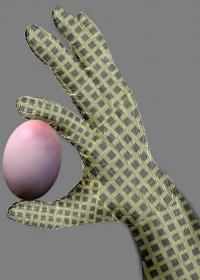Sep 16 2010
Researchers at the University of California, Berkeley, have created an artificial skin with a nanowire active matrix circuitry casing the hand. This e-skin is the first such fabric prepared from inorganic crystalline semiconductors. Their work has been published online on September 12 in the journal, ‘Nature Materials’.
Ali Javey, Head of the UC Berkeley research team, creating the artificial skin has stated that their focus was to develop a material which is sensitive to touch, thereby resembling the human skin. He said that this e-skin would help in acclimatizing the amount of force required to handle various types of objects, thereby providing solutions to the biggest task faced in robotics. He added that by incorporating this artificial skin into the robot, it can sense the objects and can perform various activities like grasping a stock pot without tumbling it and handling fragile items like wine glasses, etc.
 Artificial skin with nano matrix
Artificial skin with nano matrix
It was reported that the future attempts of these researchers will be to employ this e-skin in the artificial limbs of the patients, thereby reinstating touch sensitivity. This demands further research on incorporating these electronic sensing elements into the nervous system of the human body.
Javey said that the earlier efforts in developing this e-skin required organic substances since they can be quickly processed and are adaptable. But the major drawback is that these biological materials are bad semiconductors. Hence the electronic gadgets developed from these substances would consume high power to function the circuit. Alternatively, inorganic substances like crystalline silicon with outstanding electrical properties require low power to operate and they are chemically durable. Their non-adaptive and fragile nature has been considered by these researchers and they found that the highly reduced forms of wires made of inorganic substances are extremely pliable, suitable for high performing sensors and electronics.
The scientists developed germanium or silicon nanowires on the surface of a cylinder, stuck onto an adhesive substrate made of polyamide. This process results in the deposition of the nano wires on the substrate film systematically, from which slender pliable electronic material sheets could be developed. It was reported that other than polyamide, plastics, glass or even paper can be employed as a substrate material. Another additional method used by the scientists involves growing the nanowires on a horizontal substrate and then relocating it to the polyamide layer by using a direction-rubbing method.
For developing the artificial skin, the researchers deposited the nanowires onto an 18-by-19 pixel square matrix and every side measured 7 cm. Every pixel had a transistor built of numerous semiconductor nanowires. In order to offer sensitivity, pressure responsive rubber transistors were incorporated into the top of these transistors. The nanowire matrix maintained its heftiness even after being exposed to more than 2000 bending cycles. They require a power input of less than 5V to operate. The scientists examined the capacity of the artificial skin to sense pressure ranging from 0 to 15 kilopascals, which equalizes the force involved in the regular activities of a person.
Kuniharu Takei, Study Lead Author, has stated that their method can be scaled up for future needs. This research was funded by the National Science Foundation and the Defense Advanced Research Projects Agency.